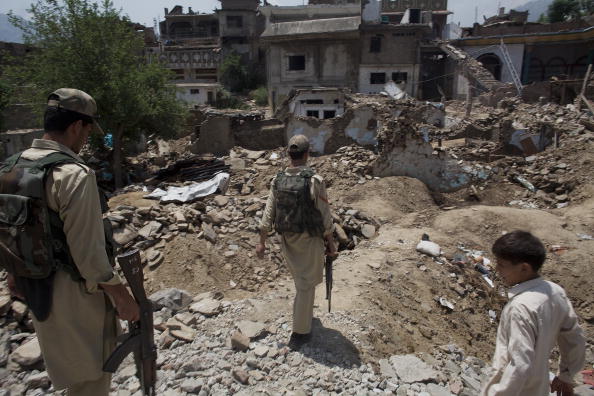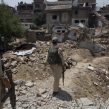
Pakistan’s Military Examines its Options in North Waziristan
Publication: Terrorism Monitor Volume: 8 Issue: 5
By:

The United States has been pressuring Pakistan for several months to extend its counterinsurgency operations to North Waziristan. The U.S. perspective is that strong militant entities, especially the Haqqani group, the Hizb-i-Islami led by Gulbuddin Hekmaytar and Taliban forces under Hafiz Gul Bahadur are using the safe haven of North Waziristan to conduct raids on American, NATO and Afghan troops. Pakistan is resisting the immediate expansion of the conflict due to several factors, one of which is that Islamabad feels its military is already overcommitted in South Waziristan, Swat and Malakand and needs time to consolidate the gains it has achieved in these places before undertaking any further operations. More than 150,000 military and paramilitary forces are currently deployed in the tribal agencies and the North-West Frontier Province (NWFP) in order to clear pockets of resistance, prevent the recurrence of militant attacks, and hold the territory that has been cleared until it stabilizes. The military has claimed the capture and killing of hundreds of militants during the operations, but the Taliban’s top leadership and many hard-core militants managed to escape in thickly forested areas or flee to adjoining tribal agencies. Conditions in Bajaur and Momand remain fairly volatile and clashes between security forces and militants are frequently reported. Remote areas of South Waziristan close to the border with North Waziristan continue to provide sanctuary to the Taliban and other militant entities that are now the target of U.S. drones.
Prioritizing North Waziristan
In the current operational environment, North Waziristan is not an immediate priority for Pakistan’s army. The militant entities in this area are not hostile toward Pakistan. It is generally believed that there is a tacit understanding that the Pakistan Army will not launch an operation if the tribes and militant groups stay neutral while operations against the Mahsud tribes and stabilization efforts continue in South Waziristan. The militant groups have not kept entirely to their undertaking and have given refuge to both al-Qaeda and Taliban leaders of South Waziristan. Another factor inhibiting a future offensive is the possibility of all the tribes uniting against the Pakistan Army in the event it launched an operation in North Waziristan. This would bring the Afghan and Pakistani Taliban closer, posing a formidable threat to regional security. The Taliban in North Waziristan number anywhere from 10,000 to 12,000 fighters and they have the advantage of local terrain that is very inhospitable to forces from other parts of the country. The local Taliban in North Waziristan have support from a cross-section of people. Those who oppose them fear retaliation as the government’s writ is practically non-existent in the region.
North Waziristan has been a victim of gross neglect by successive governments. Pakistan’s participation in the Afghan anti-communist jihad, the subsequent abandonment of the region by the United States and the international community and finally the impact of the events of 9/11 have totally destroyed the social, tribal and administrative structure of the area, encouraging the Taliban to fill the vacuum. They are in fact running a parallel administration, providing justice in accordance with their harsh interpretation of Islam and maintaining security by imposing ruthless measures. The Haqqani Network and other groups have militias of 3,000 to 4,000 fighters and could draw more from the adjoining provinces of Afghanistan if Islamabad launches a military operation. Militants fleeing from South Waziristan and other parts of the tribal agencies have also sought refuge in the area.
Islamabad does not want to antagonize the Afghan Taliban and other militant groups residing in North Waziristan, knowing that it will have to deal with them once American and NATO forces leave. The new U.S. strategy on Afghanistan already envisages a withdrawal of forces commencing in 18 months and there is talk of bringing the reconcilable Taliban to the negotiating table. The other Coalition contributors have no intention to remain in Afghanistan any longer than necessary. In such unpredictable conditions, Pakistan would like to keep its options open and watch closely how U.S. policy and the military situation evolve.
The Indian Equation
The Indian factor is crucial to the strategic calculus Pakistan uses in formulating policy on Afghanistan and the Taliban. With tensions high since the Mumbai terrorist attack and several provocative statements by Indian military and political leaders, Pakistan finds it difficult to relocate its forces from its eastern Indian border west to the Afghanistan border. U.S. Secretary of Defense Robert Gates’ statement in New Delhi that India’s patience would be exhausted in the event of another terrorist attack on India by jihadi groups has given additional reason to be more circumspect in shifting forces (The Hindu, January 20).
A further inhibiting factor in the extension of military operation in North Waziristan is the danger that it could trigger a fresh wave of suicide attacks in many parts of Pakistan, as was experienced during military operations in Swat and more recently in South Waziristan. The high human and financial cost is another important consideration. Pakistan has lost more than 2,000 men from its security forces and thousands of civilians in its fight against militants. The financial cost of insurgency is already taking its toll, with the defense budget exceeding the allocated amount by over 35 % while demands for more money, weapons and equipment are rising. It is estimated that Pakistan has suffered a loss of nearly $28 billion for being a front line state in the fight against militants. [1] When U.S. assistance is withheld due to bureaucratic hurdles it compounds Pakistan’s ongoing financial crisis.
A recent statement by Army spokesperson General Athar Abbas made it clear that the army has no intention of launching a major military operation for the next six to twelve months as it is already over-committed and busy consolidating its position in the areas of Swat, Malakand and South Waziristan (Dawn [Karachi], January 22). This must have come as a rude shock to the U.S. military commanders who have been pressing Pakistan’s military to expand its area of operations to North Waziristan. The United States wants Pakistan’s army to take on the Haqqani Network, which has close ties to Arab militants and is alleged to be involved in a number of deadly suicide attacks, including the recent suicide bombing of the CIA station in Khost province by a Jordanian triple agent (see Terrorism Monitor, January 28).
The Need for Stabilization and Consolidation
The absence of a military operation in the near future means that the frequency of drone attacks on North Waziristan will continue or even intensify. It gives rise to considerable local resentment and sharpens anti-American sentiment while presenting a moral and political dilemma for the government, notwithstanding its tactical advantage.
There is no doubt that operations in Swat, Malakand and South Waziristan have been largely successful, but there are pockets of these areas still in the hands of the militants, though the leadership has fled into other tribal agencies, principally North Waziristan, Orakzai and Momand.
It is estimated that there are roughly 100 hard-core al-Qaeda operatives and about 2,000 auxiliary members and supporters. In the frontier region, Uzbeks constitute the largest group among al-Qaeda’s foreign mujahideen, with Arabs, Uighurs, Tajiks and a few individuals from African countries constituting the rest. Nearly a dozen of the mainly Arab hard-core al-Qaeda have been killed or captured in the last few months.
Rebuilding Local Administrations
The civilian administration has yet to be made fully functional in Malakand division and in South Waziristan. Tribes opposed to the Taliban are being mobilized to take care of local security and support the government’s efforts in establishing an administrative structure commensurate with tribal traditions. This may take time but is a very critical part of the operation. Several pro- government leaders opposed to the Taliban have been killed, which has been demoralizing for pro-government tribes and groups. Furthermore, there has been a large internal displacement of people during the military operations. From South Waziristan alone, nearly 300,000 persons were displaced and remain either in camps or as guests in adjoining settled areas. Hospitable conditions need to be created so these people will not fall prey to the machinations of the Taliban when they return. There is already considerable resentment among them that they were caught in the crossfire of the military and Taliban.
It is encouraging, however, that the fight against militancy is being pursued more enthusiastically now than it was during President Musharraf’s rule. With the support of the civilian government, Chief of Army Staff General Ashfaq Parvez Kayani has shown the determination and will to seriously engage in counterinsurgency and counterterrorism operations according to the government’s priorities.
Conclusion
The government is currently unprepared to negotiate with the Tehrik-e-Taliban Pakistan (TTP) leadership. At this stage it aims at ruthlessly pursuing the leaders and their groups. However, it is important to understand that the TTP is a loose network of motley and disparate groups that have coalesced to leverage their impact but have little in common. In South Waziristan, the heartland of the resistance, the Taliban could be characterized as ideologically motivated. In North Waziristan the situation is similar. In Khyber Agency, however, criminals, smugglers and the drug mafia have worn the mantle of the Taliban to challenge the authority of the state.
In Khurram Agency sectarian groups are fighting for turf and in Orakzai and Bajaur a mix of ideology and criminality acts as an incentive for insurgency. These groups will continue to cause trouble for quite a while. However, if the government and the military remain steadfast and pursue the militant leaders and their groups vigorously according to a well-conceived plan involving both military and other elements of national power, there are good prospects for pacifying the area in two to three years. Much, of course, will depend on how the situation unfolds in Afghanistan and the extent of international support to Pakistan.
Notes:
1. According to economist Shahid Hasan Siddiqui, Pakistan has spent $40 billion on the war on terrorism while being compensated only $12 billion by the United States. See Pakistan German Business Forum, Seminar on Post Budget Implications on Business by PGBF, February 1, https://www.pgbf.com.pk/press-7-28-09.asp ).





